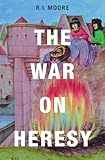The War on Heresy / R. I. Moore.
Material type: TextPublisher: Cambridge, MA : Harvard University Press, [2012]Copyright date: ©2012Description: 1 online resource (384 p.) : 10 color illustrations, 12 halftones, 8 mapsContent type:
TextPublisher: Cambridge, MA : Harvard University Press, [2012]Copyright date: ©2012Description: 1 online resource (384 p.) : 10 color illustrations, 12 halftones, 8 mapsContent type: - 9780674065376
- 273.6 23
- BT1319 .M67 2012
- online - DeGruyter
| Item type | Current library | Call number | URL | Status | Notes | Barcode | |
|---|---|---|---|---|---|---|---|
 eBook
eBook
|
Biblioteca "Angelicum" Pont. Univ. S.Tommaso d'Aquino Nuvola online | online - DeGruyter (Browse shelf(Opens below)) | Online access | Not for loan (Accesso limitato) | Accesso per gli utenti autorizzati / Access for authorized users | (dgr)9780674065376 |
Frontmatter -- Contents -- List of Maps -- List of Illustrations -- Preface -- Map -- Prologue: Death and a maiden -- Part One. Cry Havoc -- 1. The avenging flames -- 2. The gift of the Holy Spirit -- 3. The apostolic life -- 4. Monks, miracles and Manichees -- 5. The simoniac heresy -- 6. Routing out these detestable plagues -- 7. Sowers of the word -- 8. Sheep in the midst of wolves -- 9. Making enemies -- Part Two. The Dogs of War -- 10. Exposed to contumely and persecution -- 11. Sounding the alarm -- 12. Drawing the lines -- 13. Speaking of principles -- 14. The enemy at the gate -- 15. To war and arms -- 16. Politics by other means -- 17. The sleep of reason -- 18. The vineyard of the lord -- Epilogue: A winter journey -- Afterword: The war among the scholars -- Chronology -- Further Reading -- Notes -- Glossary -- Biographical Index of Names -- Index
restricted access online access with authorization star
http://purl.org/coar/access_right/c_16ec
Between 1000 and 1250, the Catholic Church confronted the threat of heresy with increasing force. Some of the most portentous events in medieval history—the Cathar crusade, the persecution and mass burnings of heretics, the papal inquisition established to identify and suppress beliefs that departed from the true religion—date from this period. Fear of heresy molded European society for the rest of the Middle Ages and beyond, and violent persecutions of the accused left an indelible mark. Yet, as R. I. Moore suggests, the version of these events that has come down to us may be more propaganda than historical reality.Popular accounts of heretical events, most notably the Cathar crusade, are derived from thirteenth-century inquisitors who saw organized heretical movements as a threat to society. Skeptical of the reliability of their reports, Moore reaches back to earlier contemporaneous sources, where he learns a startling truth: no coherent opposition to Catholicism, outside the Church itself, existed. The Cathars turn out to be a mythical construction, and religious difference does not explain the origins of battles against heretic practices and beliefs. A truer explanation lies in conflicts among elites—both secular and religious—who used the specter of heresy to extend their political and cultural authority and silence opposition. By focusing on the motives, anxieties, and interests of those who waged war on heresy, Moore’s narrative reveals that early heretics may have died for their faith, but it was not because of their faith that they were put to death.
Mode of access: Internet via World Wide Web.
In English.
Description based on online resource; title from PDF title page (publisher's Web site, viewed 03. Jan 2023)


